Italy&France trip Sep18 to Oct2,2018 part 5 Château Royal D'Amboise
- alainaa2

- Mar 5, 2020
- 17 min read
Oct 19,2018
Château Royal d'Ambroise
is our Second Chateau for that day.
This is what the Ambroise once looked liked it's heyday, only the parts in blue remain to this day the rest was torn down over time.

Since Neolithic times also known as the stone age (3,000 B.C. to about 9,000 B.C.), this location has been an ideal observation spot for the Loire river. The natural ciff wall towers nearly 131 feet high, it is an exceptional natural defense. Thus making it an ideal spot for a fortress. The town just below the fortress became the main city of the Turones, a Celtic people who gave their name to the future province of Touraine. The site has been fortified since this era. The Roman legions also occupied this site, Julius Caesar himself was rather taken with this location. After the Norman invaders, King Clovis of Francs and king Alaric of Visigoths met at this sight of what is now ChateauRoyal d'Amboise.
In 1214, Touraine was occupied by Philippe Auguste, king of France. The Amboise-Chaumont family became his vassals. However, in 1431, Louis of Amboise was condemned to death for plotting against La Trémoille, the favourite of King Charles VII. Finally pardoned, Louis of Amboise nevertheless had to renounce the Château of Amboise, which was then confiscated by the Crown.
In the 15th and 16th centuries number (5) on the map Chapel of Saint-Hubert, (6) Royal Dwelling, (9) Keep courtyard (7) 12th century tower was built.
King Charles VII and his wife Queen Marie of Anjou, and there son, Louis marked the beginning of the French kings’ residence in the Loire Valley.
King Louis XI liked living in his manor at Plessis-Lès-Tours he decided to turn Amboise into the residence for Queen Charlotte of Savoy during this time frame the only access to the château was by a drawbridge near the " Lions Gate" (1) on map.
Queen Charlotte had several children including Charles, the dauphin born in 1470 at Amboise. Charles won Margaret of Austria hand in 1482. Charles was 12 and Margret was 3. On June 22,1483 Margret arrived at Amboise. They where engaged and married in 1483. King Louis XI died on August 30,1483. Queen Charlotte passed away on December 1,1483.
Charles was crowned king at the age of 13 and became King Charles VIII. King Charles VIII spent his childhood here, he loved Amboise and because of this Amboise became royal residence. His sister Anne of Beaujeu acted as regent until he was old enough to reign.
In 1486 Charles VIII was 16 there was a plot against his reign led by Louis of Orléans the Kings cousin, who went over to the side of Duke of Brittany and Maximilian I of Austria. Anne of Brittany was a duchess became embroiled in a rivalry between the Habsburgs and the Valois. During this war her father the Duke of Brittany, died and left Anne as his heir. When King Charles VIII reached his majority he obtained the cancellation of Anne's engagement to Maximilian I of Austria and broke off his own union to Margaret of Austria so he could marry Anne of Brittany.
In 1429 King Charles VIII and Anne of Brittany where married there union was at Langeais the estate of count of Dunois who was the chief negotiator to determine the conditions for this alliance between France and Brittany. All this happened because his cousin Louis of Orléans plotted agenst him. Margaret was given her marching orders and Queen Anne made her entry into Amboise on December 31,1491.
Anne was regularly with child but all their offspring died young.They never had an heir to the France thorn that lived. Anne had a strong character, was said to be morbidly jealous it is said that after she became Charles VII wife there was very few nights she did not sleep with her husband, also had a passion for the arts and literature and was also well educated.
Also in the year of 1429 the chateau will see Joan of Arc pass by throw the small town at the bass of chateau. History will tells the story:
"The meeting in 1429 between Joan of Arc and the Dauphin, the future Charles VII, whom she later led to coronation after liberating Orleans from the hands of the English, changed the course of French history. If ever there was a decisive meeting for the history of France, it was the one between Joan of Arc and Charles VII. Just as the Dauphin was giving up all hope of reclaiming his throne from the English, he heard of a young girl from Lorraine who had received a divine message announcing her predestination to save the king and the whole kingdom. The king received the Maid of Orleans in Chinon {Chinon is one day walking from D'Amboise} on 25th February 1429, and the faith and courage of the young girl, who was aged only 17, convinced the king to lend her troops to free Orleans. On this march to Orleans, Joan of Arc passed through the town of Amboise. Examinations were carried out to verify her virginity and good faith, and following this Joan returned to the king for a second audience known as the “sign”, which ended in her official presentation. She brought the king a gold crown which was a material “sign” of her promise to lead him to his coronation. Joan then left to join the army gathered in Blois ready to march on Orleans. In May of the same year, Joan of Arc delivered Orleans from the English and the prophecy proved to be accurate. She saved the country and brought its heir to the throne. On 17th July 1429, Charles VII was crowned king of France in Reims beside the Maid of Orleans and her proud banner."
The Chapel of Saint-Hubert :
The chapel was completed in 1493 is a late Gothic masterpiece. This is the all that remains of this part of the chateau. The chapel has its original sculpted friezes below the arched vaults and, on the outside above the entrance door, its superb lintel from the late 15th century sculpted by Flemish artists Pierre Mynart. The decoration represents the conversion of Hubert the patron of the hunters. Saint Christopher carrying the infant Jesus and Saint Anthony of Alexandria portrayed as a hermit. Most of the work was don when the king was gone fighting in Italy from 1494-1495 to press home his claim to the kingdom of Naples. Nearly a hundred builders were working at Amboise during this time frame.
{Leonardo da Vinci arrived at Amboise in 1516, at the invitation of King François I. He passed away three years later (1519) and was buried in the garden then later moved to Saint-Hubert’s Chapel. A bust marks the original location of his initial burial in the garden, in the 19th century he was moved to the chapel.}
The two royal residence
In 1494 construction for the king and queen's wing started. On the southern side King Charles VII built Anne the house of the seven virtues (4 on the map) and Charles VII wing is a L-shape (13 on map) was to stand opposite to the queen's wing. The king's wing was not finished until the reign of Louis XII there is very little information about this part of the château, the only remaining part still standing, then about the buildings that have disappeared. What we do know is that Raymond de Dezest had the responsibility and control for the building Amboise. was a close friend of King Charles VII. Also during this time the Heurtault and Minimes tower where also built (2 and 14 on map).
In 1496 King Charles VII came back from Italian expedition was a dismal Political failure but his chest were full of books, paintings, sculptures, he also returned with artists, tailors, embroiderers, goldsmiths, perfumers and a parrot trainer all to lodged at Amboise.
On Charles VII return work on the château had proceeded swiftly he was frustrated not to be able to give the château more of a Italian look. The fireplace in the main hall and the keystones of the Minimes Tower did get a Renaissance touch. Charles VIII also took an interest in the outdoor spaces and planned to create a terrace garden behind the king's wing, he entrusted this to the Italian Pacello de Mercogliano. But King Charles VII did not live to see the garden finished. King Charles VII suddenly died on April 7, 1498 when he hit his head on the lintel ( a horizontal support of timber, stone, across the top) of a doorway in this château.
The premature death of Charles VIII, at age of 28 years, prevented him from seeing his great project completed. When Charles VIII died without a male heir, his cousin, the Duke of Orléans, succeeded him under the name of Louis XII.
In order to keep the French fold, Louis XII had to marry the dead king’s widow on January 8, 1499 in the chateau in Nantes {Nantes is a two day walk from Amboise}. Thus, Anne of Brittany became the only woman in French history to hold the title of queen twice.
Anne of Brittany and the new King Louis XII are cousin. The new king and his queen would live in Blois. Anne had all her belongings movied leaving Amboise empty...the king gave permission to Louis of Savoy the widow of Count Charles of Angouleme and the mother of King Francis I to movie to Amboise some time in 1499. She moved in with her two children Marguerite and François.
Some time in 1503, Louis XII continued the building projects initiated by his predecessor durning this time frame all the numbers not mention before is built and completed the Heurtault Tower in the perpendicular wing of his predecessor’s Loggia, the vaults, the machicolations, the battlement walk were finished. After this the cration of the gardens started.
In 1514 Queen Anne passed away in Blois and King Louis XII passed away the next year. Once again because of male hairs the kingdom passed on to the next male relation. That will be Francis I who grow up Amboise. King Francis I married Princess Claude, she is the older daughter of the late King Louis XII and Anne of Brittany.
After his childhood at the château and his accession to the thrown, on January 1, 1515. Because of the deep attachment and love for this place they frequently lived here and he continued building. He enlarged the Louis XII wing, add another storey. Along with small details such as facade decorated with pilastered to the windows, new flooring in the queens apartments.
Durning the years the royal nursery at Amboise had Louise in 1515, the next year came Charlotte and then Francois in 1518.Under the reign of Francis I the chateau had lots of celebrations and ceremonies: Royal wedding of the Duke Antoine of Lorraine to Renee of Bourdon-Montpensier at the Collegiate church (does not stand anymore) in 1515.
François left France for Italy and won the Battle of Marignano in September of that year.
François love for literature and the arts made him a great Renaissance patron king. He invited numerous Italian artists to Amboise, like Leonardo da Vinci who resided there from 1516 to 1519. during this time frame Leonardo painted the Mona Lisa, and Saint Anne. He also did a drawing of the chateau from the southern side of the town.
On April 25 1518 was the baptism of the dauphin Fracois. The next day was the wedding of Lorenzo de'Medici and Madeleine de la Tour d'Auvergne this union will bring in to the pitcher Catherine de'Medicie.
1930 King Francis I is now a widower and married Eleanorof Austria the sister of Charles V.
On October 17 and 18, 1534 the " affair of the Placards",was basily an incident in which anti-Catholic posters appeared in public places in Paris and in four major provincial cities, Blois, Rouen, Tours and Orléans.One was actually posted on the bedchamber door of King Francis I at Amboise, an affront and a breach of security that left him shaken. After this incident the king stay in the Loire less frequent. He spent more time in Paris and had all the furniture removed from Amboise in 1539. When Francis died in 1547 Amboise was abandoned.
The Chateau Royal D'Amboise was like a sleeping beauty waiting for some one to come wake her up. When the time came it was not one person it was two woman. Catherine de'Medici wife to now King Henry II, their children grew up here. The other woman was Diane of Poitiers the king's mistress. Both woman were passionate about architecture.
All of the construction Catherine had done does not stand today but she had the fallowing done: construction of a building parallel to the Louis XII wing in which he created apartments for the French royal children. As for Diane she had hoped olive here with her family. She had planes to build but here planes never happened.
On July 10,1559 in a jousts tournament to celebrate the marriage of his daughter Elisabeth of Valois to King Philip II of Spain. During a jousting match, King Henry II, wearing the colors of his mistress Diane de Poitiers, was wounded in the eye by a fragment of the splintered lance of Gabriel Montgomery, captain of the King's Scottish Guard. Despite the efforts of royal surgeon Ambroise Paré, the king died of sepsis. After Henry death, his wife Catherine de Medici assumed the kingdom’s regency.It was she and the Guise family who effectively controlled the country : the duke of Guise was lieutenant general of the realm.
After the death of Henri II Catherine de Medici her three sons: François II and his wife Mary Stuart Queen of Scotland, Charles IX, and Henri III lived at Amboise.
The Chateau Royal D'Amboise was the backdrop for the D'Amboise conspiracy also called Tumult of Amboise.
At the death of Henry II in 1559, the Protestants of France looked forward to a relaxation of stringent policies against their religion, but the young king Francis II, retained his father's policy. Among the king's advisors were his wife's uncles, Francis, Duke of Guise and Charles of Guise, Cardinal of Lorraine, who were the great protectors of the Catholic faith.
After the execution of Anne de Bourg, counsellor to the parliament of Paris. For that reason, some members of the Reformation(Protestants) movement felt threatened. The plotters met in Nantes (is a two-day walk from Amboise) on February 1,1560 to but the finishing touches to their plan. It is said that Queen of Elizabeth I, England sent financial contribution to conspiracy.
The Plot; a group of provincial aristocrats decided to take matters into their own hands, by kidnapping the King and arresting the brothers Guise.
The chief conspirators was was Jean Du Barry, nobleman from Parigord and Godefroy de Barry, seigneur de La Renaudie, of Périgord. La Renaudie gathered round him like-minded Huguenot gentlemen representing various regions of France: Charles de Castelnau de Chalosse, Bouchard d'Aubeterre, Edme de Ferrière-Maligny (brother of Jean de Ferrieres), Captains Mazères, Cañizares, Sainte-Marie and Lignières, Jean d'Aubigné (father of Agrippa d'Aubigné) and Ardoin de Porcelet. Paulon de Mauvans, whose brother had been executed, rallied the Huguenots of Provence at Mérindol,
This plan was set to go into practice at Bloison on March 15 how ever the Guises heard about the rumors the Guises decided to transfer King and court from Blois to Amboise, a more defensible site, and strengthened the castle's defenses.
On March 17, 1560 the conspirators, led by La Renaudie, attempted to storm the Château. Though the court was thrown into panic, the plotters' forces were easily defeated.
La Renaudie, caught on 19 March, could not find date of Jean Du Barry. The leaders drawn and quartered and his flesh displayed at the gates of the town. Some of the leaders where also hung from the chateau wall on the balcony of the king's wing or drowned in the Loire river.
La Renaudie's followers, between 1,200 and 1,500, were also killed and their corpses hung on iron hooks on the façade of the Château and from nearby trees; others were drowned in the Loire or exposed to the fury of the towns people of Amboise. T
After this tragic episode, Catherine de Medici had the château’s east defenses reinforced and gave orders for the construction of a bastion. This marked the beginning of the war of Religion in France, and the end of era for the chateau as a royal residence, and turn back into a simple forttress/prison. Catherine de'Medici moved the royal family members to Chenonceau.....
(In the paintings below is Charles VII and Anne the Portraits are contemporary. The background show the chateaus at Amboise for the king and Nantes for the queen. Charles VII and his wife, Anne of Brittany, left a lasting mark on D'Amboise. The king called upon French masons, Flemish sculptors. Whit his return from Italy, Italian artisans: carpenters, gardeners and architects. At that time, the château had 220 rooms.The king’s emblems and monograms – the flaming sword – and queen Anne of Brittany’s ermine, visible in the château’s rooms bear witness to the royal couple’s presence. )
Drummers Hall -
Got its name when Louis XIV was staying at the châteauin 1661, because of the musicians who played at the many dances and feasts held there. The floor is terra-cotta tiles with the flour-de-lis patterns and is furnished with a Gothic dresser, a Charles VII chest is under a Flemish tapestry from the late 16th century. This is where the two portraits we talked about earlier. The statue over the chair is of Saint Louis from the 14th century.
The Great Council Chamber-
Before taking any kind of action the monarch would ask for advice from his council. They met in this large chamber in the kings wing. this room saw joy but also sadness. The pillar base has a flour-de-lis or ermine motifs, their decoration was to combining the emblems o France and of the Duchy of Brittany. Also evoked by escutcheons of Charles VII and Anne of Brittany on the gothic mantelpiece and also their initials on the ceiling.
The Cupbearer's room-
Is the richly furnished of all the rooms in the Renaissance wing. It has two very elegant 16th century tables in a Italian style. Has a Gothic honer credence and two ceremonial chairs, and a chest from a walnut wood from ether the 15 and 16th centuries. The tapestries the Banquest of Queen Esther woven in the 17th century.
The Henry II Bed Chamber-
This bedroom is decorated in the Renaissance style. The curtains and tapestries are from the Brussels and Tournai the door is late 16th century.In front of the replica bed of the era is a double-bottomed jewel chest.A early Renaissance settle and a gothic straight backed bench.This room used to be a small pavilion built at the wishes of Henry II's wife Catherine de'Medici, but does not any longer exist but her presence is evoked by her portrait (I do not have a photo of this portrait).
Orléans-penthièvre Apartment-
Duchess of Orléans inherited the estate in 1793. Around the grand piano and harp the 19th century and lots of portraits.
Going out on to the Roof then down the Minimes Tower
Outside other side where we started and the gardens.
King Francis II died on March 5,1556 in Orléans Loiret, from an ear condition. Multiple diseases have been suggested, such as mastoiditis, meningitis, or otitis exacerbated into an abscess. He was only 17 years old. Only one year after his coronation crowning him king.
Amboise retained its function as a stronghold because of its strategic location, but became a residence for French sovereigns who stayed there during their travels around the kingdom.During its time as a fortress, The Prince of joinville the duke of Elbeuf and Cardinal Charles de Bourbon were imprisoned at Amboise after the assassination of the Duke of Guise in Blois in 1588.
King Charles IX (was king for 14 years had no male heir) and Henri III (was king for 42 years had no male heir), royal visits to the Château became less frequent. As such, Amboise progressively stopped being the seat of the French court.
Both King Henri IV (king for 21 years had son Louis XIII) and King Louis XIII (King for 33 years had son Louis XIV) both keen hunters and riders made short stays at Amboise.
In 1620, Louis XIII ordered the construction of new defences. However, due to lack of maintenance the château began to fall into disrepair. The main parts of the loggia inside the western part of the château (between the St. Hubert Chapel and the Charles VIII Loggia) were demolished between 1627 and 1660.
In 1627 Amboise was passed on to Gaston d'Orleans, the brother of King Louis XII, but Gaston died in 1660. After that the younger brother Louis XIV stayed at Amboise.
Amboise was also used as a prison. Famous prisoners were held there, for example Nicolas Fouquet, Louis XIV’s superintendent of finances, who was disgraced in 1661. He was accompanied to Amboise by the famous captain of the Musketeers, d’Artagnan.
Cells were made at the bottom of both towers (Minimes and Heurtault) for POW's ( prisoners of war).
In the 18th century thanks to Étienne-François, Duke of Choiseul, a powerful minister of Louis XV. Amboise finally awoke from its slumber. The Duke became the property’s owner in 1763. But by this time the lack of regular maintenance left Amboise in poor state. When Choiseul died the crown bought the estate.
Then in 1786, the crown given Amboise to Louis-Jean-Marie de Bourbon, Duke of Penthièvre, legitimate grandson of Louis XIV. 1789, he refurbished the living areas.
He went ahead with the destruction of the Great Hall’s columns and partitions. He created a panoramic dining room in the Minimes Tower. He ordered works in the gardens, during which the lime trees were planted in zigzags on the North terrace, and created an English-style park. On the fortress’s western corner, he built a Chinese-style pagoda on the Garçonnet tower.
In 1789, there was a fire in the Loggia of the Seven Virtues
The French Revolution definitively changed the The château’s Royal D'Amboise destiny.
In 1793, the authorities confiscated the Château and its contents in order to turn it into a detention centre and a barracks for veterans from campaigns led by the revolutionary armies. During this dismantling, essential elements of the Château’s decoration disappeared: panelling, fireplaces, statues, paintings, ironwork, woodwork, etc…
After a fleeting hope that they might recover their belongings, the duke of Penthièvre’s heir, Louise-Marie-Adelaide the Duchess of Orléans, was exiled due to the decree that obliged the Bourbons to leave France. During this time a fire destroyed the house of the seven virtues.
In 1803, Amboise was given to Senator Roger Ducos, a former member of the Directory. The First Consul of Napoléon Bonaparte. Bonaparte wished to thank the Senator for his help in seizing power and gift the Château’ in 1806, then the Senator ordered the destruction the Loggia of the Seven Virtues and neighboring buildings. Most notably, he destroyed the Henri II wing and the St. Florentin Collegiate Church and the canon’s house. The garden was also redone. All the works were completed in 1811.
In 1814, during the first Restoration, the Château was given back to the Duke of Penthièvre’s heir, Louise-Marie-Adelaide de Bourbon, Duchess of Orléans, returned from her Spanish exile. The Duchess only stayed in Amboise only once in July 1818 after the the starting to refurbish the rooms. On her death in 1821, the duchess passed on the Amboise to her son Louis-Philippe, future king of the French.
When Louis-Philippe ascending to the throw in 1830, King Loui-Philippe wed Maria Amalia of Naples and Sicily on November 25 1809. He undertook renovations to transform the château into his royal residence.The new king set about having the remaining buildings restored, acquiring furniture that to this day is still in Amboise These works were entrusted to the renowned architect Pierre-François-Léonard Fontaine, the work was done from 1839 to 1842 and then his student, Pierre-Bernard Lefranc 1795-1856.
The work done by Fontaine and Lefeanc was: there was several houses next to or connector to the outer wall were demolished, a tunnels dug through the rock, the basement of the old house Seven Virtues were converted into the new stables, the flooring and ceilings in the royal apartments were redone and the stain glass for the Saint-Hubert chapel was order from Sèveres.
Louis-Philippe defender of French heritage, supported the classification of monuments that were emblematic of the nation’s history, and Amboise, classified in 1840, was one of the top ranking.
The 1848 Revolution led to the exile of Louis-Philippe and the château was taken by the nation.
For awhile it was used again as a prison. Its notable prisoner was the Emir Abd El-kader. Was a formidable adversary of the French colonial power and in particular the Duke of Aumale, the son of King Louis-Philppe. The Emir stay at Amboise November 1848. He lived in the Charles VII apartments along with his family and servants 96 people in all. He was given his freedmen October 16,1852 During his meeting with the future Napoleon III. Several members of his entourage who died during his captivity are buried in the gardens at Amboise.
In 1873, Amboise once again return to the Orléans family or more precisely to the Count of Paris, Philippe d'Orleans
Since Amboise was listed as an historic monument 1840 the State appointed an architect to lead the works. The architect in question, was Victor-Marie-Charles Ruprich-Robert. In 1887 Vitor died and then his son Gabriel after him, both inspectors of historic monuments. They achieved remarkable restoration work on the St. Hubert Chapel, Charles VIII Loggia and the Minimes Tower, then the Renaissance wing and the Heurtault tower. The restoration carried out under Louis-Philippe on the chapel was the masonry was redone and the roof was topped with the tall spire we see today..... and so much more.......
The Count of Paris died in 1894. In 1895 Amboise was bought by Count of Paris uncle, the Duke of Aumale. The Duke of Aumale died three years later and in 1901 the château, which already housed a hospice, was transformed according to his wishes into a clinic for former staff from his family’s household.
The final tragic episode for the Château and the town of Amboise occurred during the Second World War. In June 1940, the French army was routed and progressively withdrew south of the Loire. The château’s royal loggia was thus the German troops’ entrance to Amboise.
There was considerable damage about a hundred shells fell on the château affecting the Chapel, and the Garçonnet and Minimes Towers. The château suffered for 15 days from the uncontrolled influx of refugees and German troops. Then, it was used by the occupying troops as an arms depot and a post for aerial communications and detection.
In July 1944, the château was bombed by the Allies, which damaged the loggia façades and the St Hubert Chapel’s stained-glass windows and roof. On August 1, 1944 the last German army units left the château.
A short vedio of our vist
Oct 19-20 Night stay at Château de la Bourdisiere.
More to come soon...















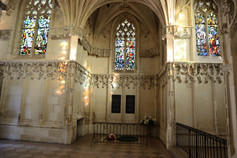











































































































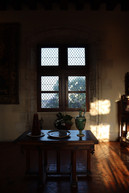












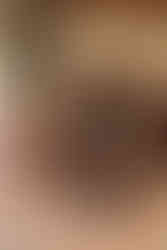










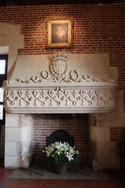




































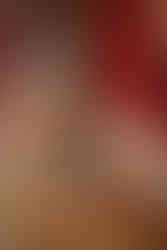




































































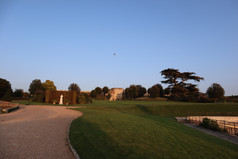







































Comments